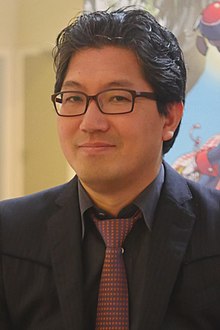Portal:Video games
The Video Games Portal

A video game, also known as a computer game or just a game, is an electronic game that involves interaction with a user interface or input device (such as a joystick, controller, keyboard, or motion sensing device) to generate visual feedback from a display device, most commonly shown in a video format on a television set, computer monitor, flat-panel display or touchscreen on handheld devices, or a virtual reality headset. Most modern video games are audiovisual, with audio complement delivered through speakers or headphones, and sometimes also with other types of sensory feedback (e.g., haptic technology that provides tactile sensations). Some video games also allow microphone and webcam inputs for in-game chatting and livestreaming.
Video games are typically categorized according to their hardware platform, which traditionally includes arcade video games, console games, and computer (PC) games; the latter also encompasses LAN games, online games, and browser games. More recently, the video game industry has expanded onto mobile gaming through mobile devices (such as smartphones and tablet computers), virtual and augmented reality systems, and remote cloud gaming. Video games are also classified into a wide range of genres based on their style of gameplay and target audience. (Full article...)
Featured articles –
The game continues the open-world tradition of its predecessors by allowing the player to travel anywhere in the game world at any time and to ignore or postpone the main storyline indefinitely. A perpetual objective for players is to improve their character's skills, which are numerical representations of certain abilities. Early in the game, seven skills are selected by the player as major skills for their character, with those remaining termed as minor skills.
Development for Oblivion began in 2002, directly after the release of Morrowind, opting for tighter pacing in gameplay and greater plot focus than in past titles. To design the graphics, Bethesda used an improved Havok physics engine, high-dynamic-range lighting, procedural content generation tools that allowed developers to quickly create detailed terrains, and the Radiant AI system, which enabled non-player characters (NPCs) to make choices and engage in behaviors more complex than in past titles. The game features fully voiced NPCs—a first for the series—and the music of composer Jeremy Soule. (Full article...)
It is the first 2D side-scrolling game for the Nintendo 64, and Treasure's first release for a Nintendo console. The 12-person team began development in mid-1995 with little knowledge of the prototype console. The team wanted to make a novel gameplay mechanic, and implementing the resultant "catching" technique became their most difficult task. The game was announced at the 1997 Electronic Entertainment Expo and was released in Japan on June 27 that year and later in the United States, Europe, and Australia.
Mischief Makers received mixed reviews. Critics praised its inventiveness, personality, and boss fights, but criticized its short length, low difficulty, low replay value, sound, and harsh introductory learning curve. Retrospective reviewers disagreed with the originally poor reception, and multiple reviewers noted Marina's signature "Shake, shake!" sound bite as a highlight. Video game journalists appealed for its reissue either through the Nintendo eShop or in a sequel or franchise reboot. In 2009, GamesRadar called it possibly the most underrated Nintendo 64 game. (Full article...)
The majority of the book is divided into four short stories by different writers and artists from the computer game and comic industries. Each story focuses on different aspects of the Halo universe, revealing stories that are tangential to the main plot of the game. Apart from the stories, the book also contains an extensive art gallery compiled of contributions from Bungie, Marvel and independent sources.
Released on July 19, 2006, The Halo Graphic Novel was well-received, with reviewers noting the cohesiveness of the work as a whole, as well as the diversity of the individual material. The success of the novel led to Marvel announcing a new limited comic series, Halo: Uprising, and other future Halo comic books. (Full article...)
Did you know... -
- ... that when Kaz Ayabe pitched his video game Boku no Natsuyasumi to Sony, he said that illustrator Mineko Ueda was interested in the project even though they had never actually met?
- ... that the web-based video game Moderator Mayhem was based on a card game meant to demonstrate the difficulties of content moderation?
- ... that the team developing the action video game Knights Contract researched European folklore on witches and witch hunts?
- ... that the urban legend Herobrine was ranked on a Guinness World Records poll of the best video game villains, despite never existing?
- ... that the name of the video game mod series Bomba Patch was inspired by éclairs?
- ... that the illustrations in the 1992 video game Tetris Classic are based on scenes from Alexander Pushkin's poem Ruslan and Ludmila?
- ... that the 2014 text adventure The Uncle Who Works for Nintendo is inspired by a source cited by children for spreading video game rumors?
- ... that Through the Darkest of Times was the first video game published in Germany to use swastikas?
- ... that the video game Fursan al-Aqsa received an update that allows players to reenact the October 7 attacks on Israel?
- ... that approximately 85 percent of Manhattan was recreated for the 2008 video game The Incredible Hulk?
- ... that after becoming paralyzed from the neck down, Rocky "RockyNoHands" Stoutenburgh broke two Guinness World Records in the video game Fortnite?
- ... that the video game JFK Reloaded recreates the assassination of John F. Kennedy from the perspective of the killer?
Selected biography –
Selected image -

Recent video game-related events
- September 12, 2024 – 2023–2024 video game industry layoffs
- Microsoft announces that it will lay off 650 Microsoft Gaming employees as part of cuts to its workforce. (Variety)
- August 15, 2024 –
- American video game magazine Game Informer discontinues publication after 33 years. The magazine's website is also shut down. (BBC News)
- May 24, 2024 – Uvalde school shooting
- Families in Uvalde, Texas, U.S., file a lawsuit against Daniel Defense and Activision Blizzard for creating the DDM4 V7 gun and promoting the weapon through the game Call of Duty, respectively. They also sue Meta Platforms for owning Instagram, which was used by the gunman. (AP)
Topics
Categories
Things you can do
In other Wikimedia projects
The following Wikimedia Foundation sister projects provide more on this subject:
-
Commons
Free media repository -
Wikibooks
Free textbooks and manuals -
Wikidata
Free knowledge base -
Wikinews
Free-content news -
Wikiquote
Collection of quotations -
Wikisource
Free-content library -
Wikiversity
Free learning tools -
Wiktionary
Dictionary and thesaurus












































